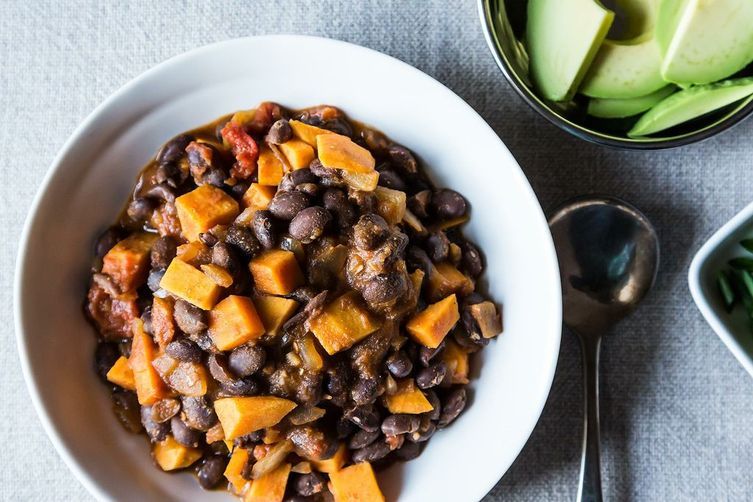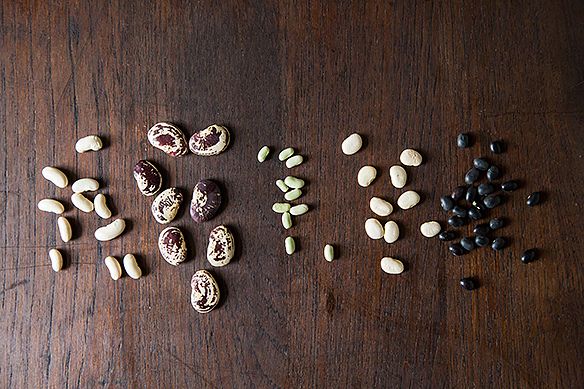Gena Hamshaw of the blog Choosing Raw eats a mostly raw, vegan diet without losing time, money, or her sanity. Let her show you how to make "rabbit food" taste delicious and satisfying every other Thursday on Food52.
Today: Gena shares tips for cooking beans, and a recipe for a hearty vegan chili.

Legumes are my favorite source of protein. In addition to their high protein content, beans are also good sources of iron, which can be tricky to obtain easily on a vegan diet.
But here’s the thing about beans: a lot of people are scared of them, because…well, you know the old adage.
The problem is actually a starch (oligosaccharide, if we’re getting technical) in legumes for which we have a limited digestive enzyme. We can build up more of the enzyme, though, by eating beans more regularly. Given how healthy they are, it’s in our best interest to do just that. In addition, we can make beans more digestible by using certain tricks of the trade. Here are some of my favorites.

Soak your beans before cooking. Making beans from scratch is cheap, easy, and eliminates any unsavory BPA from canning. Soaking the beans is an essential part of the cooking process. It reduces cooking time and it also helps to release the oligosaccharides that can cause us stomach discomfort. You can either do a “quick soak” or a “long soak.”
For a quick soak, rinse and pick over your beans, cover them with water (1 part beans: 3 parts water) and boil them for five minutes. Let them sit for an hour after, and then cook through.
For a long soak, pick over and clean beans, cover them in water (1 part beans : 3 parts water) and then let them soak 8 hours, or overnight. Drain and change water before cooking through. For most beans, this will mean about an hour of simmering.
Cook beans with a strip of kombu. I used to wonder why people did this, until I was told that kombu actually contains some of the enzyme we need to digest beans. Cooking beans with kombu is standard in macrobiotic cooking, and many believe that it can make a big difference.
Spice things up. In traditional Indian cooking, spices are thought to improve the digestibility of legumes, perhaps by lending some of their own enzymes to the cooking process. Indian spices used in bean preparation include ginger, turmeric, fennel and asafoetida. Adding a strip of ginger to your cooking liquid is a great idea.
Add beans to your soup. The broth and liquid will first absorb, and then cook off, some of the resistant oligosaccharides, which may help you to digest the beans.
A drop of acid never hurts. Once beans are already tender, add some acid to them (vinegar, lemon, etc.). It will both increase digestibility and also help to make the nutrients in the beans more bioavailable.
Always rinse. If you do use canned beans, be sure to rinse them thoroughly. Hey, we all need a shortcut now and then. When I’m really in a pinch, I love using beans from Eden Organic, which have been prepared with kombu and come in BPA free cans. Remember, though, to rinse the beans thoroughly to remove some of the unwanted starch and sodium in the canning liquid.
Two final tips: if you’re just getting into legumes as a home cook, increase your consumption gradually. Your system will build up the enzymes you need, but it’s best to add beans to your diet in increments. And if you have a hard time with them, you may want to try rounding them out with quinoa, rice, or barley (or any whole grain you love) -- some claim that beans are easier to digest when paired with other proteins that “complete” the protein profile for a meal.
For example, you can serve the following black bean and sweet potato chili, which is smoky, spicy, and basically divine, over some brown rice. If you’re having people over for a certain Sunday football game this year, I challenge you to give this recipe a shot. It’s easy and delicious, and it’ll knock the socks off any guest -- vegan, omni, and everyone in between.

Smoky Black Bean and Sweet Potato Chili
Serves 6
1 1/2 cup dried black beans
4 cups sweet potato, diced into 3/4 inch cubes
1 tablespoon olive oil
2 cups chopped white or yellow onion (about one medium to large onion)
2 cloves garlic, minced
1 chipotle pepper en adobo, chopped finely
2 teaspoons cumin powder
1/2 teaspoon smoked paprika
1 tablespoon ground chili powder
1 14 or 15 ounce can of diced tomatoes
2 cups vegetable broth (and more as needed)
sea salt to taste
1/4 cup chives, snipped into small pieces
1 large Haas avocado
See the full recipe (and save and print it) here.
For more on cooking dried beans, check out this article.
Photos by James Ransom





See what other Food52 readers are saying.